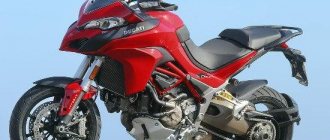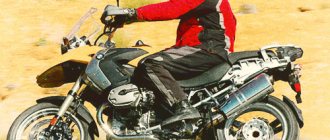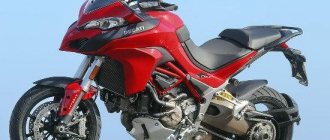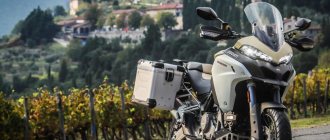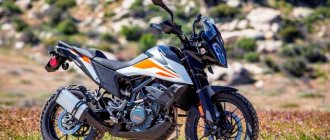Apotheosis
BMW R1200GS Adventure 2014, 1170 cm2, 125 l. s, 260 kg (curb weight),
more than 200 km/h, RUB 1,110,000.
text: Vladimir Zdorov photo: Nikita Kolobanov
In the photo: Vladimir Zdorov
»The Bavarian touring enduro GS series has long become a kind of standard - a household name that everyone who tries to play in the same league with the Germans is equal to in one way or another. And if previously BMW’s hegemony in this field was unconditional, then in the last decade a fair number of serious players have “attacked”: the geography of the “German’s” competitors starts from the Land of the Rising Sun and ends with the Apennine Peninsula. However, there are unshakable values in this world, and the only alternative for BMW R1200GS adherents can only be the R1200GS Adventure.
Hello. I’ll probably tell you about the motorcycle I spent this season in the saddle of. This is a BMW R1200GSA, a '16 dropsy. His odometer now shows just over 16,000 km and, judging by the weather outside, this number is unlikely to change noticeably.
“How did you get to this point?”
This is probably the most common question that people ask me when they find out that I switched to a BMW saddle from a KTM 990 Adventure. In general, everything was something like this. Five years ago I ditched the F800GS for a 990 Adventure and thought I'd never go back. But, as they say, “never say never”: last year, when Slonyara was waiting for spare parts, I suddenly had the urge to ride and I rented an R1200GS Adventure, but an “aircraft” of the previous generation. I won’t go into details - a separate post has been written about this, but based on the results of my first trips, I thought a lot because... In the role of a near-asphalt tourist, the motorcycle turned out to be very, very pleasant in everything except the engine. Considering that I already had a KTM EXC500 for riding through the forests, I thought - “why not”? A heavy tourist on an energy-intensive suspension is a good addition to a hard-endure vehicle transported by car.
I was riding with this thought on the same airborne GSA along the northern shore of Ladoga, when, when hitting a small hole, the motorcycle emitted a “khrrr” and began to slow down. As it turns out later, damage to the boot between the box and the pendulum (most likely in an accident) turned the latter into a vacuum cleaner for everything that flew out from under the rear wheel. Even though I understood that this was not a mistake by BMW, but a problem with this particular motorcycle, it noticeably cooled me down.
The problem was that by that time I had already decided to change the motorcycle and all that remained was to decide for what. Thoughts about completely road vehicles were quickly rejected and I concentrated on the segment of “tourendours from a liter and above.” One of the main requirements for the motorcycle was a really large power reserve, which in turn required a really big tank.
Surprisingly, only two motorcycles of this class can boast of this in stock: the R1200GS Adventure and its main competitor, the KTM 1290 Super Adventure T. To be honest, the choice was not easy and at times I still look at the KTM with interest (it’s a pity that the dealer undeservedly deprived of attention to this model). Over the 16 years of existence of the GS Adventure, the Austrians were the first to decide to compete with the Germans in this segment and, I must say, hit the target the first time: as for me, the motorcycles are very similar in the range of tasks they solve, but differ in implementation. I would even say that the differences are rather religious: cardan vs chain, quite dynamic boxer vs frankly aggressive V-Twin, patented Telelever and Paralever vs classic suspension from WP. In terms of electronic equipment, the motorcycles are neck and neck. Among other things, the Austrians have a noticeably lower price tag, but... they were not in stock, the pre-order was supposed to arrive at the end of April, and no one could convince me that I would not sit at home during the May holidays. And I went to the BMW showroom. It's funny, but I bought the previous goose (F800GS) in exactly the same way.
Really big update.
The new GSA is different in every way, and the changes start with the design: the rounded, streamlined shapes of the previous generation have been replaced by aggressively chopped ones. However, to me, the touring flagship continues to be recognizable and I am sure that anyone who has seen previous generations of this motorcycle will immediately recognize this one.
Of course, the main change is the new engine. Disputes about how permissible it is to break long-standing traditions by installing liquid cooling began simultaneously with the presentation of this very new engine and have not subsided to this day. BMW engineers decided not to waste time on trifles: in addition to increasing power and installing liquid cooling, the new engine also received a wet clutch, which, together with the gearbox, moved to the engine crankcase, a vertical intake, an electronic throttle grip and mode control.
The electronic suspension has become even more electronic, or, to be more precise, semi-active: “Dynamic” has been added to the abbreviation ESA, now the electronics not only changes the settings at your request at specified intervals - on the new geese, the brains, among other things, receive data on the operation of the suspension and, overlaying these data on traffic situation data (acceleration/braking/roll/etc), make a decision on opening/closing valves in order to change stiffness.
Among other things, the cardan with the exhaust swapped places and a glove compartment appeared (small and without a lock, but this never existed before). We’ll probably stop here; I’ll talk about smaller niggles separately.
First trips.
Early spring - somewhere around the first half of March, a goose is basking near the dealership. A huge self-propelled sofa, which with its whole appearance says “the asphalt has thawed - maybe this is a long trip?” The design has changed noticeably, but the new look is still recognizable as its predecessors - for a moment it even seems to me that this is the same air thing, just in slightly different plastic.
The controls raise a lot of questions - all my previous motorcycles had a gas handle, clutch and brake levers, and now they added all sorts of buttons. The salon manager conducts a pre-launch briefing, and I soon realize that there is somehow too much information. Okay, we'll sort it out as needed. In the meantime, first down and let's go. Before the start, out of curiosity, I pick up speed a little in neutral - the motorcycle sways slightly. Perhaps it was my imagination, but with the air gun this effect was more noticeable.
While driving around the territory, for the first time I hear this pleasant diesel tune that the engine emits when driving at low speeds. Those who spend a lot of time on long-distance trucks are probably well aware of the sound of diesel tractors with which they crawl through the parking lot. The GSA sounds very similar until about 3500 rpm, and then the engine changes voice.
As is the case with other BMWs, this bike also takes no getting used to. - as if I just took it from the winter, and before that I owned it for many years. It steers well and, what’s important, is completely predictable and confidently holds its trajectory. The semi-active suspension gives good feedback - you always know if you hit something - it’s not a breakdown or a swing - just feedback between you and the road.
Brakes. The last two bikes (F800GS and 990 Adventure) were equipped with Brembo brake systems and I couldn't ask for more - they worked perfectly. But here... it’s just some kind of drogue parachute paired with an anchor! Two radial machines at the front, working in tandem with the rear, work wonders - the motorcycle stops much earlier than you expect.
And everything seems to be great, but the engine... damn running in - 1000 kilometers in the thoughts “will you be as agile after 4000 rpm”?
Buttons.
In general, I was planning to write about the management of special stages in the section about the track, but somehow I got carried away and decided that this should be moved somewhere to the side. We will be talking about GSA in the maximum configuration (as far as I know, this is the standard for motorcycles supplied to Russia).
In terms of standard controls, everything is in its place and does not require getting used to. Let's talk about the additional ones: on the left remote control there is a navigation control dial (optional) - if your motorcycle has a native Navik (which is essentially a modified Garmin), then this is a very convenient thing. The only problem is that when angular forces are applied to the steering wheel, the disk is often accidentally squeezed out, and you have to snap it back.
The large two-section paddle on the part farthest from the driver is cruise control. In general, I considered this option completely unnecessary and even harmful, but when I used it, I realized that over long distances this thing is very convenient. In addition, it is a very convenient option over the hill, where even for small excesses you can pay a lot of money. The large part is the lock (so that the paddle hidden under it is not pressed), the small part is the control paddle itself. In addition to maintaining the selected speed, it is also possible to lower/increase it without touching the gas, or, if you have turned off cruise, return to the previous settings. The latter, I must say, greatly breaks the pattern because... the motorcycle starts to accelerate on its own. Cruise is turned off by squeezing the clutch or brake, as well as by closing the gas (additional effort when turning away from you) or switching through the quickshifter.
The next button is to switch between low and high. Among the options for the GSA there is a diode headlight with automatic switching between low beam and side position (the default mode can be selected in the menu, or you can select the mode with the button). Together with the neighbor, the PTF will automatically turn on (they can be turned off with a button at the base of the mirror base).
In the center of the left remote control there is a pair of swings - the left ones control the tidy (you can separately select two indicators - in the upper and lower parts, respectively), the right ones are more interesting: the upper part turns off ABS and anti-skid, the lower one controls the suspension modes: in addition to the basic “Soft” Normal/Hard” you can select the sub-mode “alone”, “with luggage”, “full load”.
We move from the left console to the right. On the way, instead of the usual ignition switch, you will find an “On/Off” button. The key is now not a key at all, but just a beacon for brains of the “friend or foe” type. The tank cap works on the same principle.
The right remote control is much more modest - in addition to the “Stop/Start” swing, there are only two buttons: control of the heated handles and control of the motorcycle modes. There’s not much to say about the first one except that this button is made extremely inconvenient because... In order to reach it, you have to take your hand off the gas. The second button does not create any problems and is designed to select one of the riding modes (Rain, Road, Dynamic, Enduro, Enduro Pro), each of which also changes the suspension settings (they can be overridden separately), ABS and ASC. But we'll talk about all this later.
City.
In general, I almost stopped driving around the city and when purchasing I didn’t particularly plan for this mode of use. However, the motorcycle feels completely normal in the city.
I can’t say that I can get through any row with a whiz, but confident traction at idle and a good turning radius make this task much easier. In such conditions, the heat from the open engine is noticeable, but not bothersome.
The Adventure does not give up even when actively moving in dense traffic - even with its size, in terms of controllability and response to the handle, absolutely no questions arise.
I would especially like to note the work of light. A triangle of LED headlights and two LED foglights make the motorcycle very, very noticeable in traffic.
Route.
So, as for the main area of application of flagship geese. The GSA shows by all appearances that it is maximally tailored for moving over long distances, and so it is.
The wind protection is massive: from below you are covered by the tank and engine, from above by a wide muzzle and a very high glass. When driving along a highway in moderate rain, there is a good chance of only getting your hands wet up to the elbows. Although, in my opinion, things were even better with the windproof air bag. The wind deflector is adjustable in height and angle at the same time - for a person with a height of more than 190 it is already difficult to suffice, but it can easily be replaced at an aftermarket - fortunately, there are plenty of options.
The seating position is upright, there is a fairly wide saddle under the driver, and if you ride without a passenger (or luggage in his seat), there is a good margin for movement. However, rolling out the tank at once is a rather difficult task (at least for me), after 350-400 kilometers you still feel the urge to stop. The passenger lives in a separate seat section, which is located slightly higher. I can’t call the saddle super-comfortable - it’s quite comfortable, but it could be even better (by the way, it has height adjustment).
Since we're talking about the tank, I'll tell you about the power reserve. The new GSA's tank has shrunk by 3 liters, but is still 30 liters - this is the best figure in the class (the KTM 1290 Super Adventure T has a similar volume), and the manufacturer promises a more economical engine compared to the previous generation. According to my measurements in the “calm, smooth road, smooth gas” mode, the instantaneous consumption per hundred turned out to be approximately the following: at 100 km/h - about 4.5 liters, at 150 - about 8, and about 12 liters at 200. In other words, if you are in no hurry at all - you can count on about 600 km. Although, to be honest, I only got similar numbers in Europe.
Of course, as with any motorcycle, your final mileage will greatly depend on your riding style. In general, the engine turned out to be exactly the way I imagined it - the GSA does not provoke overtly aggressive driving (which is often attributed to its main opponent), but is very conducive to dynamic driving: the DYNA mode noticeably enlivens it, and the double-sided quickshifter suddenly turns out to be useful even at such a motorcycle - this option seemed completely unnecessary to me, but it has its advantages both in cases when you want to quickly shift, and in situations when you are simply too lazy to press the clutch.
A comfortable cruiser - about 160 according to GPS (it’s still possible to make out the words in the music playing through the intercom) - when accelerating from a standstill, the GSA easily and naturally picks it up in 4th gear. Speaking of higher speeds, unlike the F800GS, behind the wheel of this motorcycle there is no desire to take a nap while waiting for the speedometer to move from 170 to 200: 4th ends at about 180, and the motorcycle does not lose agility in the next gear. And the faster you go, the more you will be glad to have a damper - I didn’t notice any problems with stability at high speeds (although I’m not a fan of such speeds and rarely do this).
Separately, I would like to note that BMW engineers managed to combine in one motorcycle both good directional stability and sharp (by the standards of its class) handling. So, for example, this year on the M4, with a strong wind blowing obliquely into the muzzle, the goose easily maintained cruising speed and did not require much course correction. At the same time, if you want to actively maneuver, it won’t give you any trouble in this case either.
Priming.
Let's get one thing straight: I don't expect miracles from a motorcycle with a curb weight of 260 kg, a cardan shaft and almost road-sized wheels. I don't recommend it to you either.
As expected, the GSA rides perfectly fine on a medium-kill grader and has no problems doing it quite quickly (about 80-90 km/h). The suspension is enough for high-speed testing, yes, it shakes, but that’s not the point - you can drive and it seems even for a long time.
My next descent to the dirt began with a fall, when I decided to pass a sandy piece with gas, and the electronics (being in road mode) rushed to save me - the anti-box strangled the engine, the motorcycle almost stopped and I lay down to rest. By the way, at that time I had my first experience of lifting the GSA into a vertical position. A motorcycle that in most cases remains lying at an angle of ~40 degrees is comfortable.
With the safety systems disabled and the suspension loosened in the forest, it behaves better than many SUVs (thanks to the boxer engine, which reduces the CG, and the suspension reserve), but relative to middle-weight touring enduros, the heavy muzzle and 19/17 wheels make their own adjustments to the handling. Although, for example, I was pleasantly surprised that a GSA shod in slicks with the electronics turned off behaves completely predictably on the trajectory when the rear wheel is deliberately stalled.
Regarding the differences from the previous generation, I would like to note that the vertical intake has significantly raised the air filter and is now located just below the steering column, which noticeably raised the waterline (previously the filter was located between the tank and the seat, the situation was also aggravated by the air intake from the height of the right boiler).
In general, for me, the GSA's off-road capabilities look like this: if you meaningfully drive it deep into the forest and your goal is more distant than a camp a couple of kilometers from a paved road (and this is not necessarily asphalt) - you are clearly doing something not this way.
“What about scolding?”
I talked about the pros, let me write about the cons. Although, to be honest, I have almost no complaints. He told me about the unsafe button for turning on the heating, and about the not very convenient navigation control dial - apparently the same.
At about 13-14k km, the gearbox suddenly began to work noticeably noisier (and at times these sounds scared me), but studying AdvRider showed that this is the norm for this model: if you want quiet shifting, use the quickshifter, or adapt to the peculiarities of the brain helping you set the speed. True, then this symptom disappeared somewhere and returns extremely rarely.
There is also a noisy story connected with the new geese about the fact that often the front fork stays do not withstand heavy loads on off-road and, as a result, the GSA can turn into a unicycle. Fortunately, I don’t have such experience myself, but the recall launched in the fall will fix this problem on my motorcycle as well.
And, of course, the price. Frankly speaking, the difference with the competitor is such that if I had a choice, most likely I would become the owner of the 1290. This does not mean at all that GSA is not worth the money and that I am in any way unhappy with it - far from it. The point is that for a noticeably smaller amount you can get a motorcycle that is very similar in capabilities.
Results. Actually, that’s probably all I have. The senior GSA of the latest generation is a motorcycle, although created from scratch, but at the same time it is an excellent continuation of the opposition traditions. While developing the new Adventure, BMW was able to not only update its flagship in this class, but also were not afraid to do serious work on the mistakes, closing all the inconvenient issues related to the engine. In my opinion, it turned out great.
As for my expectations, this is exactly what I wanted. Over the course of the year, there was never a situation where Adventure was lacking in something or limited me in some way. It seems to me that this is a very good indicator.
Tourenduro in its natural habitat.
Sun. Desert. Tourenduro in its natural habitat.
And although their manufacturers also have more off-road models - the R1200GS Adventure, Multistrada Enduro and 1290 Super Adventure R (not to mention the 1090 Adventure R), the models in this comparison were chosen for a reason: they all have a sporty bent. It's no joke: 370 horses for three.
Ducati 1260 Multistrada S, BMW R1200GS, KTM 1290 Super Adventure S - 370 horses for three
Our Europeans are very similar in characteristics. They all have a twin-cylinder engine, cage frames, a dizzying array of electronic gadgets and top-of-the-line components. Yes, and they cost a lot, but for their price you get traction control with tilt angle monitoring, semi-active suspension with electronic settings, anti-skid system on a slope, quickshifter, ABS with cornering optimization, keyless entry, heated grips, cruise control, sensors tire pressure and the devil in the mortar. But although they are functionally very similar, there are also differences.
About the power curve and torque
The last GS we tested produced 11 more horsepower. larger than the example in this review. BMW assures that Euro4 standards should not be blamed for this, but does not explain what this difference is due to. Peak power is achieved at 8420 rpm. Part of the KTM's phenomenal power comes from its ultra-linear power curve. The Ducati produces the highest numbers and has the highest cut-off ceiling, but its low end is a little worse than the rest. BMW on the graph has the maximum number of peaks and troughs, but on the road it behaves like a true Aryan, self-possessed and predictable. The KTM is a torque monster, especially from low to mid. It produces maximum torque 1000 rpm earlier than the Ducati, and only a couple of points earlier than the BMW. The previous version of the Multistrada, on the 1200m motor, had a gaping dip in the mid-range, and the significantly flatter curve of the 1260m motor is a significant improvement. The increase in torque at medium is 18%.


